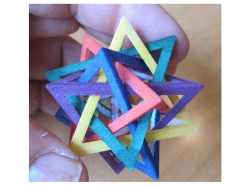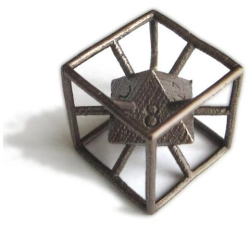3D printers are ace. People are using them to make all sorts of cool things. If you can describe a shape to a computer, it’s very easy to send that description to a 3D printer, which will happily smoosh some substrates together to make a real model of your shape. Mathematicians are able to describe all sorts of crazy shapes, in exactly the amount of detail computers need, so they’ve taken to 3D printing like ducks to water.
Thingiverse is just a repository for designs, so if you see something you like you’ll have to find your own 3D printer. Shapeways makes the objects and posts them to you; prices can vary from just a few euros to hundreds, depending on the size of the object and the materials used.
As with all other kinds of mathematical art, there’s a huge amount of repetition of the same few ideas, but also a few really interesting and unique designs. I’ve picked a couple of representatives from each of the popular topics, but do search around if you want a version with slightly different parameters; you’re bound to find something suitable.
For the past few months I’ve been quietly compiling a list of interesting mathematical objects I’ve found on the main 3D printing catalogues, Thingiverse and Shapeways. With Christmas approaching, I thought now would be as good a time as any to share what I’ve found.
Pretty things
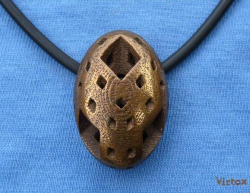 Approximations to Sierpinski gaskets and Menger sponges are popular subjects for 3D printers. For example, I’ve found a Sierpinski Icosahedron by Christopher Kroll, a Sierpinski tetrahedron by Wahtah and this intricate Menger sponge by Bathsheba Sculptures (or a smaller one by Terra Cotta Personal Fabrication). Virtox sells a variety of Mengerish pendants, such as the “Menger pebble” to the right.
Approximations to Sierpinski gaskets and Menger sponges are popular subjects for 3D printers. For example, I’ve found a Sierpinski Icosahedron by Christopher Kroll, a Sierpinski tetrahedron by Wahtah and this intricate Menger sponge by Bathsheba Sculptures (or a smaller one by Terra Cotta Personal Fabrication). Virtox sells a variety of Mengerish pendants, such as the “Menger pebble” to the right.
 Continuing with fractals, the Koch snowflake makes for fitting decorations at this time of year. George Bell has designed a rather nice Koch snowflake Christmas tree ornament. A simpler, flattened pendant is available from Glacier Designs, or kick it up a dimension with this Koch snowflake sponge by Eric Baird.
Continuing with fractals, the Koch snowflake makes for fitting decorations at this time of year. George Bell has designed a rather nice Koch snowflake Christmas tree ornament. A simpler, flattened pendant is available from Glacier Designs, or kick it up a dimension with this Koch snowflake sponge by Eric Baird.
The arrangement of five interlocking tetrahedra is quite easy to make (mathematically speaking) but looks really nice. George Bell has made a small one in five colours, and a bigger one with an icosahedron sat in the middle. I’ve found a free design on Thingiverse by csrdfr if you want to print one yourself.
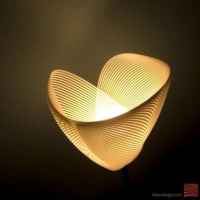 This plaque with the first 225 digits of π jumping out of it by tianyulu is quite gloriously useless and a massive underuse of the possibilities opened up by 3D printing. The designer describes it as “perfect for maths geeks and idiots!”. I think I agree, if we interpret ‘and’ to mean the interseection of sets.
This plaque with the first 225 digits of π jumping out of it by tianyulu is quite gloriously useless and a massive underuse of the possibilities opened up by 3D printing. The designer describes it as “perfect for maths geeks and idiots!”. I think I agree, if we interpret ‘and’ to mean the interseection of sets.
You could class your living up with the very elegant (and expensive) Clothoid.B lamp by alienology. The clothoid is one of my favourite geometrical objects, so this grabbed my eye straight away. It’s rather lovely.
Playful things
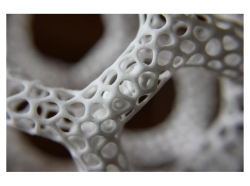 The ability to create interlocking or enveloping objects in a way that wouldn’t be possible with conventional casting or sculpting methods allows all sorts of fun toys and games to be made. A nice example is the Voronoi runner by Froland’s. It’s a dodecahedral mesh with five balls moving freely inside the edges.
The ability to create interlocking or enveloping objects in a way that wouldn’t be possible with conventional casting or sculpting methods allows all sorts of fun toys and games to be made. A nice example is the Voronoi runner by Froland’s. It’s a dodecahedral mesh with five balls moving freely inside the edges.
A quite enormous selection of unusual dice is available to buy on Shapeways. The Double D6 Dice by The Magic Shop consists of an almost-normal D6 encaged in a die whose value is given by the sum of the dots visible on the corners. The two pieces can move independently, and the distribution of values given by adding the two dice is the same as rolling two normal six-sided dice.
The Average D6 cage die, also by The Magic Shop, works the same as a normal D6 but you have to take the average of the numbers of the visible faces to calculate your score. The Magic Shop sells a bewildering array of unusual and awkward dice. Rather than describe them all here, I recommend you have a look at their Shapeways shop.
If you’ve given up on maths and want to just pick a number out of the air, the dodecahedral Comma Die by Kaetemi will help you decide. Its faces hold the digits 0-9, a minus sign and a comma.
 I wasn’t exaggerating about the number of different dice available on Shapeways; Kevin Cook has collected hundreds of designs on his site, DiceCollector.com.
I wasn’t exaggerating about the number of different dice available on Shapeways; Kevin Cook has collected hundreds of designs on his site, DiceCollector.com.
Entertain doubting Thomases with this jigsaw proof of a single case of Pythagoras’ theorem by Glyphobet. The pieces used to make the equilateral triangle attached to the hypotenuse can be rearranged to make the equilateral triangles attached to the other two sides.
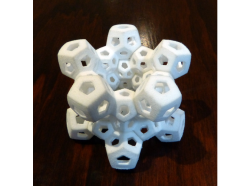 This chain of stacked rhombic dodecahedra by Emmett Lalish “makes a decent rattle”. He’s subsequently made a loop of the same shapes which drapes itself nicely over whatever it’s put on.
This chain of stacked rhombic dodecahedra by Emmett Lalish “makes a decent rattle”. He’s subsequently made a loop of the same shapes which drapes itself nicely over whatever it’s put on.
Henry Segerman and Saul Schleimer’s 30-cell puzzle asks you to assemble five identical pieces into a part of the stereographic projection of the radial projection of the 120-cell to the three-sphere. It fits together rather neatly.
Interesting things
Solids of constant width are, I would say, a prime candidate for 3d printing, since they’re so hard to make by hand. George Bell has made two sets of solids of revolution based on Reauleaux polygons, while clsn has one-upped him with a couple of rather fetching Meissner tetrahedra.
The sphericon is a solid with one side and two edges. When its rolls, if it rolls for long enough, every point on the shape comes in contact with the surface it’s rolling on. While there are a few of those available on Shapeways, it’s much cheaper to make a wireframe version consisting of just the edges. The freely rolling konoid by GeoMachine is one such. They also sell an oloid, which has the same property.
 The Truchet tile can make all sorts of interesting patterns on the plane. Owen Stenseth has published a design for a set of Truchet tiles on Thingiverse.
The Truchet tile can make all sorts of interesting patterns on the plane. Owen Stenseth has published a design for a set of Truchet tiles on Thingiverse.
The Szilassi polyhedron has only 7 faces and is topologically equivalent to a doughnut, and constitutes a proof that 7 colours are needed to colour a map on a torus. Richard Gain has made one on Thingiverse and Charles Steinkuehler has made its dual, the Csaszar polyhedron, which looks like $K_7$ so has no diagonals.
Hypotrochoids are the kind of curves created by Spirographs. Virtox has created a system of gears based on a hypotrochoid. He says, “it is printed as a 9 piece puzzle, a VERY frustrating one at that.”
People
I started this post by saying that there’s a huge amount of repetition in what’s available for 3D printers. There are a few people making the most of the medium with really interesting and novel objects.
 George Hart has been making mathematical things for decades, and is still going strong. He’s taken up 3D printing with gusto and shares the files to make many of his creations on his webpage.
George Hart has been making mathematical things for decades, and is still going strong. He’s taken up 3D printing with gusto and shares the files to make many of his creations on his webpage.
Henry Segerman, along with his collaborator Saul Schleimer, has been making artistic twists on commonly- and less-commonly-known mathematical objects, as well as some interesting puzzles and knick-knacks. It’s hard to pick just a couple of favourites, but I think his developing fractal curves are great, and he seems to have mastered the art of printing complicated surfaces.
 Bathsheba sculpture has been making mathematically-inspired sculpture since before it was fashionable. They’re perhaps most famous for the Klein Bottle Opener. In their Shapeways shop they sell a selection of both aesthetically and mathematically pleasing pieces of art.
Bathsheba sculpture has been making mathematically-inspired sculpture since before it was fashionable. They’re perhaps most famous for the Klein Bottle Opener. In their Shapeways shop they sell a selection of both aesthetically and mathematically pleasing pieces of art.
Oskar van Deventer is a legend in the puzzling world. His Shapeways shop doesn’t disappoint, with over 200 different puzzles to stretch your brain.
Finally, I’ll note that Shapeways is giving the 11th of December as its deadline for orders to be shipped to the US or Europe, and the 9th for anywhere else. Bear that in mind when writing your Christmas list!
